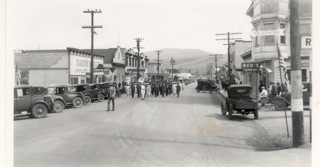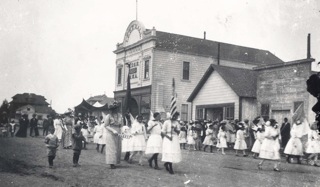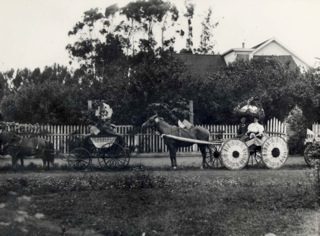[Image below: A small march down Main Street when “Red’s” stood across the way from Isadore’s Garage, all long gone. I will add pix of much older 4th of July photos for your enjoyment.]

An old-new story by June Morrall (I wrote this in the 1970s)
July 4th Celebrations at Half Moon Bay in the 1890s: A Portrait of One Day
All day long a steady stream of visitors poured into Half Moon Bay, many of them from as far away as San Francisco. By noon, the line of horse and buggies parked along Main Street resembled a crowded city scene.
A local newspaper estimated that at least 300 “strangers,” showed up, adding up to one of the largest gatherings ever seen in the 1890s to celebrate the Fourth of July.
The townspeople were prepared. As early as the day before, they were busy getting ready for the 114th anniversary of American independence. Everyone pitched in to decorate, draping bunting and streamers over business establishments and private homes.
Not only the American flag, but a display of banners from all over the world produced an instant flash of color. It was a warm, lightly breezy day and the flags lazily floated out of all but a few homes in the entire “valley.”
Overnight the old Coastside town achieved a patriotic look.
Promptly, at sunrise, early pioneer W.A. Simmons fired the town’s five pound cannon and led the national salute. Soon afterward, droves of folks arrived from the country in a holiday mood. Young and old dressed for the special occasion, filling Main Street, a dirt road then, as the popping sound of small firecrackers filled the air.
It seems that whenever a committee is responsible for a big event, like this Fourth of July in the 1890s, there were differences between the members that had to be worked out–and they were, according to some amicably solved.
Others said the plans almost backfired.
But on the day of the event you wouldn’t know there had been any troubles, and the rolling vehicles, prancing horses and excited children pointed to a successful, lively atmosphere.
[Image below: A Half Moon Bay float….]

The crowd’s noise was muffled when the ceremonial unfurling of the flags began in unison from the roofs of the businesses on and around Main Street including Levy Brothers, R.I. Knapp’s Plow Factory, William Pringle’s Harness Shop, Boitano Brothers and Debenedetti’s.
But the sound of loud firecrackers soon broke the solemnity of the moment as clusters of visitors started talking above the noise, looking forward to the next event: the parade.

It was early in the morning, and at 10 a.m. sharp, the honorary “president of the day” headed for Schuyler’s Hotel to take his place at the head of the procession. All the movers and shakers took their place as they marched down Kelly Street, preceded by the Half Moon Bay Cornet Band , in their third public appearance, opening up with a rousing rendition of the “Star Spangled Banner.” Behind the band was the eye-catching Fourth of July float, dressed up with pretty local girls, carefully decorated and drawn by an impressive team of horses moving at a fast pace.
Once on Main Street, the parade turned south toward Miramontes Street; the procession stopped outside the school located nearby. (Meanwhile children scrambled to catch-up, as the older folk strolled alone or rode along slowly in their carriages. Yes, it was a Norman Rockwell scene.)
Near the school, and in the shade of a grove of big old Cedar trees, stood a recently constructed stage, also decorated with heavy bunting and flags. At the time, what was called a tableaux,” where “actors and actresses” created a live picture, a symbolic statement, was anxiously awaited. This day’s tableaux was called “Colonial Times,” and it was obvious as the nervous actors, 13 identically attired girls in all-white, assembled on the stage. Each girl bore a sash with a name of the original 13 colonies.
But more actors joined the group representing “Liberty,” “Army,” “Navy,” “George and Lady Washington,” all frozen in a symbolic silence.
The event’s “presidents” role was to introduce the participants as well as the children and adults who read poetry or sang, for that was the popular entertainment of the 1890s. [In fact, when the eccentric Tunitas Creek sculptress Sybil Easterday was a child, she acquired fame for her cuteness as well as her elocution skills.]
There were a series of recitations, names of which we are unfamiliar with today: “Independence Day,” “E Pluribus Unum, and halfway through the program Rev. B.F. Taylor delivered an uplifting address. The program ended with the audience singing “America,” as the curtain dropped on the frozen tableaux.
The Half Moon Bay Cornet Band struck up a tune called “Our Flag is There,” and the inexperienced school kids did their best singing in tune the exciting number known as “Red, White and Blue.”
All this made for great fun, and at the right moment, a new flag was raised by school officials. It was a perfect day. The flag fluttered in the light breeze followed by a growing ripple of applause from the crowd.

More festivities followed with a grand party at the “Pacific Hall,” with music provided by the Melville Brothers, a popular contemporary band. At midnight the the ladies committee served a hot meal at the Ocean Shore Hotel (the location of which I do not know as I do not know where the “Pacific Hall” stood, either.) This Fourth of July was so much fun for everyone that no one wanted to leave until dawn approached.
————-
But the following year, when the Fourth of July rolled around, the event was disorganized, without focus and direction. It was the sudden death of an important citizen, and the subsequent funeral, that threw all the plans for the celebration off schedule.
The committee was frazzled without their leader, so recently buried. [No I do not know who he or she was.] The festivities did not begin at 10 a.m. but four hours later; the band did not play on time. Songs were canceled, and so were the literary recitations.
Things got so bad that the committee just wanted the event to be over. They didn’t even want it to happen, but there were those expectations. The schoolchildren were encouraged to rush through their carefully prepared performance; the Declaration of Independence was hastily read, the words mumbled. Usually a highlight, hardly anyone showed up for the afternoon barbecue. The entire day was an embarrassment.
The dark clouds of a ruined event just wouldn’t let the sunshine in. The day included a baseball game between the Monitors and the Scrubs and the usually avid fans could muster any enthusiasm when, after three quick innings, the Monitors clinched the title.
The only redeeming feature were the famous horse races held on Main Street (trotting, buggy and half-mile races) The rural farming community had a deep respect for fine Coastside horses, and that excitement drew the crowds. [You might notice a few balconies that still exist above businesses on Main Street from which families watched the races and parades.]
This Fourth of July that began in a shaky state got better when locals competed in foot races to demonstrate their physical agility. In the 100 yard sprint, Joe Quinlan, came in first and won a silk shirt. There were races for married men and an unscheduled race between two mules.
In the end, although this Fourth of July could have been a total disaster, a couple of hundred guests showed up at the Pacific Hall for supper, and the Fourth of July committee, although thrown off without their capable leader, declared the day a partial success.
more to come….
